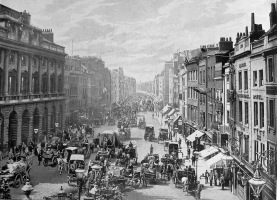 The Strand, late Victorian era.
The Strand, late Victorian era.
 The Strand, late Victorian era.
The Strand, late Victorian era.
The walk along the Strand from Trafalgar Square is not spectacular but allows us to see some significant sculpture – Charing Cross, ruined work by Epstein, the facades of Somerset House and the sculpture by John Bacon, and the important sculptural groups near the end - the Gladstone Monument, the sculpture for Australia House, and the Temple Bar Monument. Also to be seen are the two freestanding churches which actually stand in the road and around which the traffic has to flow, and the great Royal Courts of Justice. We note various minor things along the way.
Start from Trafalgar Square. At the entrance to Strand, to the left is the side of South Africa House, with a high relief of an antelope, and three keystones with antelope and perhaps wildebeest heads. Opposite, the late 19th Century corner building has elegant arched entrances with keystone heads.
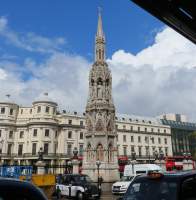
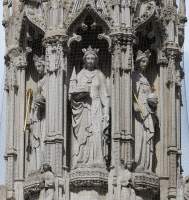 Charing Cross, Coutts behind, and Earp's Eleanor statues.
Charing Cross, Coutts behind, and Earp's Eleanor statues.
A few paces along, the road opens up, with the Charing Cross Hotel, dating from 1863 by the architect E.M. Barry, working in Renaissance style. In front of it is the Charing Cross itself, a 19th Century recreation of one of the Eleanor Crosses, again designed by Barry, with the sculpture, including eight Queen Eleanor statues, by the sculptor Thomas Earp. Although much of the design is rather fanciful rather than able to be a close reproduction of the long-gone original Charing Cross, of which only a few engravings survived, much too is taken from the surviving Eleanor Crosses, and the Earp’s figures have a similar feel to them as those on the Eleanor Cross in Hardingstone, Northampton. Opposite the front of the Hotel, the rear and spire of St Martins in the Fields Church can be seen.
Continuing along the Strand, on the left, is the elegant but undecorated Coutts Bank building, built as part of the Strand Improvements of the 1830s. There is an interest to those with Victorian inclinations because the Coutts fortune was left to the founder’s favourite grand-daughter, Angela Burdett-Coutts, who became a philanthropist, and commissioned the building of various churches and schools.
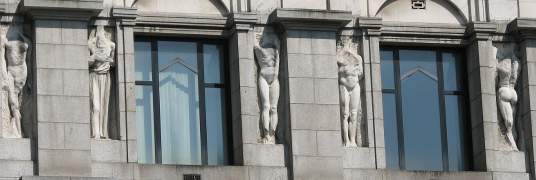 Epstein figures at 429, Strand.
Epstein figures at 429, Strand.
A little way along, Agar Street and William IV Street branch off to the left, and on the corner is no.429, Zimbabwe House, by the architect Charles Holden, of great controversy when it was erected in 1907 because of the nude Epstein figures on the exterior. Despite their height, they were mutilated almost immediately by outraged students. What survives is rather ruined, and not obviously the work of Epstein.
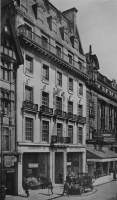 Former New Zealand House, 415 Strand.
Former New Zealand House, 415 Strand.
No. 415 on the left, now occupied by the Nationwide, was once New Zealand House, designed by the architects Crickmay and Sons and completed in 1916. This has, or had, rich interiors for the High Commissioner. The exterior is faced in Portland Stone, but with only minor fructifying festoons around some of the windows by way of decoration – the carvers were John Whitehead and Sons.
Opposite, no 55 has two early 20th century half figures in high relief stone above the door.
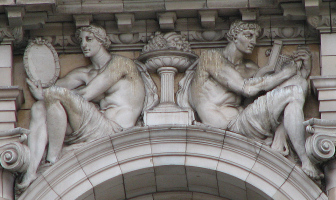
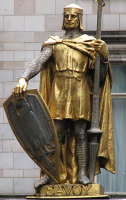
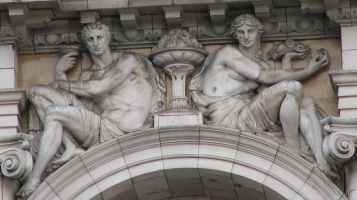 Doulton Carrara spandrel figures, and F. Lynn Jenkins's Count of Savoy.
Doulton Carrara spandrel figures, and F. Lynn Jenkins's Count of Savoy.
We proceed, past first lower, then higher and grander facades, including on the right hand side, nos. 77-88, which is the former Cecil Hotel, built by Perry and Reed in 1886, and at that time the largest hotel in Europe, with 800 rooms. Next, the Savoy Taylors Guild, with ornate wooden ground floor, and a nice dome on the corner, matched by the Savoy Buildings on the opposite corner, by the architect C. J. Phipps, and dating from 1881. Between these two is the Savoy Hotel, named after the ancient Savoy Palace which once stood on the site. The Hotel is set back along an approach, with a rather flamboyant early 20th Century statue of a noble knight above the portico, who is Peter, Count of Savoy – the sculptor was Frank Lynn Jenkins. High up on the building behind (Richard d’Oyly Carte’s Savoy Court, 1903-4), are elegant spandrel figures, rather far to see properly without some visual aid. The whole building is faced in Doulton Carrara Ware, a glazed cream-coloured terra cotta. The older block facing the river, behind this, dates from 1884 and is by the eminent T.E. Collcutt.
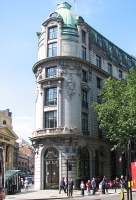
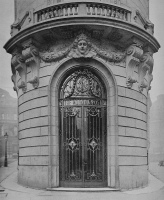
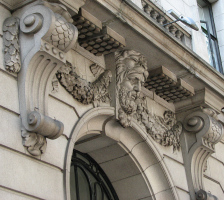 Mewes and Davis's Morning Post Building.
Mewes and Davis's Morning Post Building.
We continue eastwards, to arrive at the important cross-section where Lancaster Place goes off to Waterloo Bridge on the right, Wellington Street goes sharp left, and Aldwych opens out, also to the left, subject of a separate page. On the corner between these two streets is an impossibly thin-cornered block, the former Morning Post Building, surmounted by a cupola and most elegant, in Louis XVI style, by the architects Mewes and Davis. The building dates from 1908. There is a notable keystone head of grand size above the corner door, with festoons etc, another round the corner in Aldwych, and above the second floor level are trophies in high relief. The Norwegian granite carving was carried out by A. and F. Manuelle, and the trophies higher up may be the work of the prolific firm of H. H. Martyn and Company of Cheltenham, who carried out some of the interior carving for the building.
Gaeity Theatre, sculpture by Binney, and Lancaster Place terra cotta.
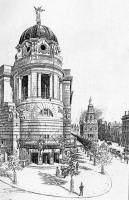
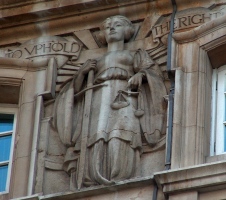
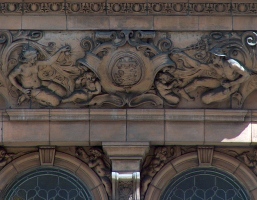
On the opposite corner of Aldwych, there once stood the famous Gaiety Theatre, put up in the 1860s, rebuilt to the design of Runtz and Ford in the 1900s when Kingsway and Aldwych were redesigned, and demolished in the 1950s after damage in WWII. Next to it in Aldwych stands the Gaiety Restaurant by Norman Shaw, now demolished but intended to retain in what ghastliness eventually emerges from the scaffolding the important original façade, with exceptional Arts and Crafts sculptural friezes by the sculptor Hibbert Binney.
The terra cotta block on the other side of the Strand, next to Lancaster Place, is no.133 Strand and rather a change from the pale stone around, somewhat in palazzo style, with many pillars and a balcony high up. It has repeated minor decorations all over, but the main embellishment is just round the corner in Lancaster Place as what passes for the principle entrance. This has small spandrels to the lights above the door, with squeezed in cherubs, and above this, a concave projection bearing figures, still in terra cotta. One of them is an allegory of Electricity, holding a lightbulb and wire, and the other is a figure of Mercury.
Somerset House, Inland Revenue side, with Cities by Theed, Britannia, and Hippogriff.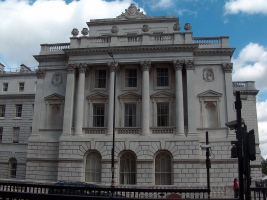
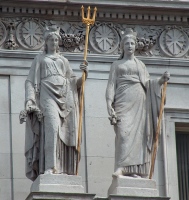
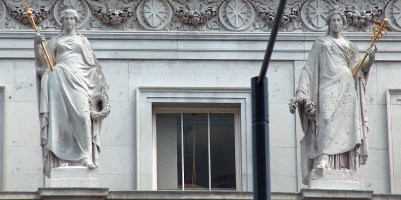
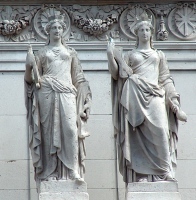
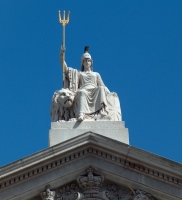
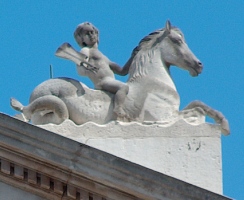
This corner block actually conceals the mass of Somerset House, last of the grand residences along the Strand between Westminster and London. The current edifice was built by William Chambers from 1776, with Robert Smirke continuing the Kings College wing in 1829, and Pennethorne adding the Inland Revenue wing in 1857. We look at the Pennethorne side first, by going a little way down Lancaster Place, and the grand façade is best viewed from the opposite side of the road. The principle statues are allegorical female figures representative of six great cities Belfast, Edinburgh, London, Manchester, Dublin and Glasgow (in order above), by the sculptor William Theed the Younger. These stand above the massive central portico. The pediment above incorporates the Royal Coat of Arms with its Lion and Unicorn supports (see this unicorns page for more), and on top of the pediment is a seated Britannia on a lion (more Britannia figures on this page), with in the acroterial positions, boys on hippogriffs. Far below, on the small entrance beside the clock, are two female figures, seated, the one of the left being an angel with a staff, and that on the right being a decorously dressed woman with an open book – appropriate symbols for the Inland Revenue, housed within this flank of the building.
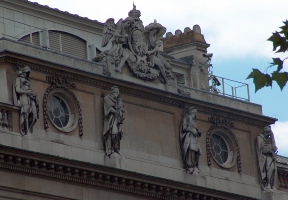
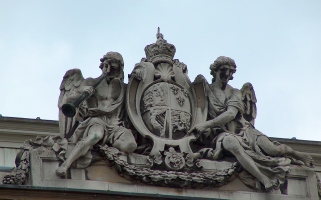
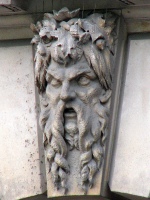
 Somerset House, facade, examples of sculpture.
Somerset House, facade, examples of sculpture.
We return to the corner and proceed along the Strand. Straight in front of us is the splendid steeple of St Mary le Strand, one of two churches in the road – more on that in a bit. But before we come to that, a few doors down is the principal entrance to Somerset House. As described in an early Victorian gazetteer: ‘The front towards Strand has nine arches supporting Corinthian columns, with emblematic figures of Ocean and the eight principle Rivers of England in alto-relievo adorning the keystones of the arches. Medallions of George III and Queen Charlotte and the Prince of Wales were formerly over the three central windows on the first floor. The attic storey has statues of Justice, Truth, Valour and Moderation, holding scales, mirror, sword and bridle respectively. The summit has the British arms, supported by figures of Fame and the Genius of England, by the eminent sculptor John Bacon the Elder.’ In the courtyard of the building is the famous sculptural group of Father Thames and George III, by the same sculptor.
Somerset House is greatly associated with things artistic. It hosted the Royal Academy’s annual exhibition from 1780-1837, and the Academy held its meetings there also from 1780-1856, when they decamped to Burlington House, their current residence (the architectural sculpture on that building is noted on this page). One wing of Somerset House contains the Courtauld Art Gallery, other galleries are to the rear, towards the Thames, and the wonderful Witt and Conway picture libraries are housed to the left of the entrance.
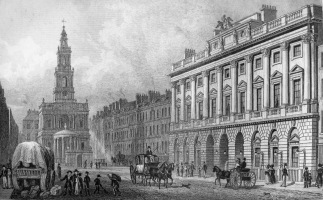 St Mary le Strand, and Somerset House.
St Mary le Strand, and Somerset House.
And now to St Mary le Strand. The current church was built in 1714-1717, by the architect James Gibbs, replacing one demolished when Somerset House was built. The style is Corinthian, with an Ionic portico, and the steeple is very beautiful as seen from further down the road, though originally the intent was to have a 250ft column with a statue of Queen Anne (who had ordered the building of the church). But Anne died, and the pillar was not built. The church was at one time famous for its maypole, ‘a last remnant of vile heathenism, round which people in holiday times used to dance’. Up above, one ornamental urn fell off when someone leant against it in 1802, killing three people.
To the left is Bush House, then on the right hand side, just past the church, is the former Strand Station with characteristic purple tiles. Proceeding, we come to an open space formed in part by the junction with the other end of Aldwych, curving round, with the second church along the road, which is St Clement Danes, and several works of outdoor sculpture, though the space as a whole is ruined by the traffic scheme and hideously out of place modern buildings.
St Clement Danes by Wren, and Hamo Thornycroft's Gladstone Monument.
St Clement Danes was rebuilt by Wren from 1680, badly damaged in WW2, and has been meticulously restored. The exterior, unlike the case for most of Wren’s churches, can be seen from all sides.
In front of the church stands the important Gladstone Monument, by the sculptor Hamo Thornycroft. We see a central bronze statue surrounded at a lower level by four allegorical seated female figures, also in bronze, with various attendant infants – rather more than his rival Disraeli got in his statue in Parliament Square. The central statue is a most characteristic and characterful rendering of the great statesman. The allegorical figures are as follows: Brotherhood to the front left – a matronly woman with two boys; Education, to the right – Woman, book, one child, with excellent pose, drapes, and face (more statues of Education may be seen on this page). To the rear right is Courage – a woman with fearful child, killing a snake with her scythe. The dramatic pose makes a good silhouette and the infant looks suitably frightened. To the rear left, Inspiration, with a book (perhaps a bible?) gazes heavenward, rather conventionally. (More pictures of the Gladstone Monument on this page; lots more allegorical statues are to be found via this page.)
Statues of Dr Johnson by Fitzgerald, and Douding and Harris by Faith Winter.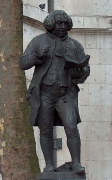
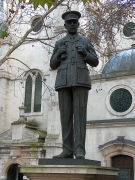
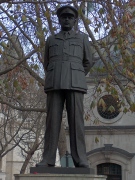
There are two other free-standing statues in front of the church - rather stiff modern statues of military men, both dated 1998, and both by Faith Winter – Lord Douding and Arthur Harris. And behind the church is Percy Fitzgerald's strange, squat statue of Samuel Johnson, with little portrait medallion of Boswell, and two small panels.
Facing the church, and thus behind us as we look at it, is Australia House, best seen from by the Gladstone. The work of the architect Marshall Mackenzie and built in 1912-18, it includes sculpture by two important sculptors. Above, we see a bronze group of Phoebus Driving the Horses of the Sun, emplaced in 1923. We see the nude sun god, with cloak and crown, arm raised, and the front halves of the four rearing horses. A group of size and confidence, by the sculptor Bertram Mackennal. Lower down, to left and right of the corner entrance to the building, we see stone figure groups by another sculptor with Australian links, Harold Parker. Monumental in size, with pyramidal compositions, they show the Awakening of Australia and the Prosperity of Australia, and are described on this page.
Looking to the right of the building is the curve of Aldwych, with the LSE building in view on the opposite side of the road, with a variety of statues by Albert Hodge – these are described on the Aldwych page on this site.
UK Provident Institution with lost sculpture by Henry Poole, and Lloyds' fish in Doulton tile.
We are almost at the end of our walk along the Strand. On the right hand side, we may note Essex Street, which leads to Middle Temple, and thence to the Temple Church, put up by the Knights Templar and retaining several Templar effigies, but not described here. On the corner where a truly grim modern lump has sprouted at no 190-196, there used to stand a building by the architect H. T. Hare for the United Kingdom Provident Institution, with sculpture by Henry Poole. Still on the south side, there remain a line of interesting buildings, with some minor sculpture. The Twinings portico has painted, seated figures of two Chinese personages (as in ‘all the tea in China’) and a lion, also painted (lots more lions on this page); these figures most likely in wood. Next along, after the sold NatWest bank at 217-218 Strand, the Lloyds Bank building at no.219 has three entrances, with large curled fishes in high relief above the outer entrances, and at 2nd floor level above the principal entrance, two Atlantes figures supporting the projecting centre of the balcony (see this page for examples of Caryatids and Atlantes); along with other, slighter decoration, a grotesque lion’s head is at the top of the pediment. The entrance hall is surfaced with Doulton tiles, and this building, formerly Palsgrave’s Head Restaurant, was put up in 1883, by the architect G. Cuthbert.
G. E. Street's Law Courts, statues of Christ, King Alfred, and King Solomon (lawgivers), and an interior view.
On the other side, the full distance to Fleet Street is now occupied by the vast structure, one of the last Victorian Gothic buildings, which forms the Royal Courts of Justice. It was put up in the 1870s and opened in 1882. To build it required clearance of 30 lanes and 4,000 people living there, and its construction used 62,000 tons of Portland stone, and, apparently, some 35 million red and white bricks, though to appreciate these you need to travel round the side and back of the building, or go inside. The architect was George Edward Street, an important figure in Victorian architecture and extremely influential, but less familiar today because he concentrated on churches rather than public buildings. Inside the Courts, the central hall is Cathedral-like in its dimensions and feel, and is comparable to the Natural History Museum in its grandeur.
The Temple Bar monument in the centre of the road, which replaced Christopher Wren’s Temple Bar gate, now by St Paul’s Cathedral, is surmounted by a superbly spiky dragon (though generally called the Griffin), by the sculptor C. B. Birch, symbol of the City of London. On the left and right sides of it, are full statues of Queen Victoria (facing the Courts) and the then Prince of Wales, later Edward VII. These are the work of J. E. Boehm. The Temple Bar monument marks the end of the Strand, and indeed the end of the City of Westminster; that which follows from this point on forms Fleet Street, and is within the bounds of the City.
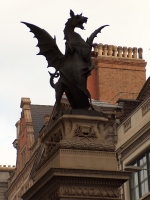 C. B. Birch's dragon silhouetted on the Temple Bar monument, marking the end of Fleet Street.
C. B. Birch's dragon silhouetted on the Temple Bar monument, marking the end of Fleet Street.
Continue East along Fleet Street
West to Trafalgar Square // Aldwych // Southwards to walk along the Embankment
Visits to this page from 13 Mar 2014: 20,155